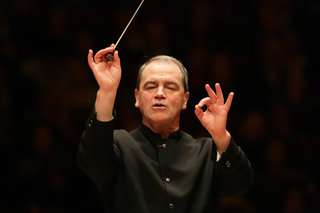|
Back
Varied Program, Glorious Sounds Houston
Jones Hall
05/13/2010 - and May 15, 16
Igor Stravinsky: Symphonies of Wind Instruments
Wolfgang Amadeus Mozart: Symphony No. 41 in C Major, K 551 (Jupiter)
John Harbison: Fanfare for Foley’s
Francis Poulenc: Gloria
Albina Shagimuratova (soprano)
Houston Symphony & Chorus, Charles Hausmann (chorus director), Hans Graf (conductor) 
H. Graf (© Chris Lee)
With solid, and at times stunning, performances, Hans Graf and his performers left the audience satisfied in this quizzical quartet of works. In what must be a rare situation, Mozart seemed the odd man out, with the Stravinsky, Harbison and Poulenc works steeped in audience-friendly modernity.
In the Stravinsky Symphonies, Graf navigated the tempo juxtapositions expertly, and his small woodwind and brass arsenal were devoted followers. The treacherously high oboe and bassoon passages were flawless, while the flute and clarinet figures possessed a jazzy, improvisational feel wholly suited to this enigmatic masterpiece. The brass were at turns punchy and poetic, and the closing chorale was finely tuned. This performance was an excellent advocate for a work that can be a hard nut to crack for many.
Graf’s polite interpretation of Mozart’s final symphony held no surprises, but the performance was a cornucopia of excellent orchestral playing, noticeably in the principal woodwinds. Tempos were brisk and ensemble was tight, the finale played with panache and superb balance throughout the contrapuntal texture. In Classical works, Graf always seems reticent to use harder timpani mallets and allow the brass to dominate from time to time, which could have added some zest to the well-mannered reading.
The inclusion of the brief Harbison fanfare was a nod to the Foley’s department store dynasty and its founders, who were devout supporters of the Houston Symphony. Harbison’s brass writing is unforgiving. A few trumpet bobbles aside, the players performed the work with verve, Graf coaxing enormous sounds from the section and, as in the Stravinsky Symphonies, precisely navigating the numerous tempo shifts. The performance made one hunger for a Houston Symphony performance of Harbison’s Double Brass Concerto.
There is much in common stylistically between Poulenc’s rhetoric and Stravinsky’s, and setting those composers as bookends for the concert was a great concept. The Frenchman’s Gloria is a work that I never tire of hearing, and this full-blooded performance brought together the best performance aspects of the previous three works. The Houston Symphony Chorus relished in Poulenc’s rhythmic quirkiness, turning on a dime from extremely soft to brilliantly forceful dynamics. Graf really let the brass and percussion play out in the work, emphasizing Poulenc’s piquant harmonies and supporting the singers wonderfully. Inviting Albina Shagimuratova, one of the Houston Grand Opera Studio’s rising stars, to sing the solo part was a brilliant idea. Her gorgeously floated initial “Domine Deus” was a harbinger of supernatural singing to come. With impeccable pitch and an uncanny ability to produce a gorgeous, healthy sound at an almost inaudible dynamic level, Shagimuratova challenged the orchestra to join her in creating some extravagantly sensuous moments. The chorus, too, dared to match her vocal virtuosity and, if there were a few tenuous moments, such as the a capella exchanges of “Amen” in the final section, these were the exception not the rule. This was a thrilling performance that only made one wonder why these excellent singers weren’t given more to sing on this program.
Marcus Karl Maroney
|